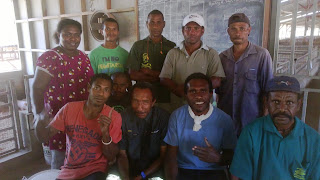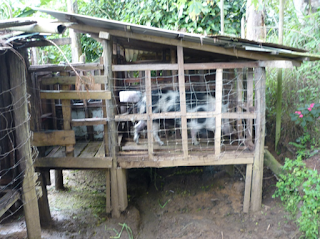7. The Pre-trial Work
In this chapter we adjust the business strategy, train staff, make silage and then the trial pigs arrived........
Although we needed only two or three people to run the trial, this was Papua New Guinea and more people, almost by definition were required. Somehow we had to find work for the existing farm staff. Desparate times, desperate measures. These measures came back to haunt us later. They cost us thousands of dollars.
I adjusted the trial and business strategy and deployed a disease eradication plan for some remaining sows on the
farm. We kept about 40 middle parity
sows to provide some cash flow and something for our staff to do while the
trial was running and before the sows farrowed. We thought we might be able to
eradicate mange ( a skin parasite) and Mycoplasma hyopneumoniae, an infectious respiratory
pathogen. I'd written a book about this stuff. Eradication of internal parasites
might have been possible in an environment where pens could be spelled and
disinfected but, in our pens, where some floors were dirt, elimination of
roundworms was a pipe dream.
Although we needed only two or three people to run the trial, this was Papua New Guinea and more people, almost by definition were required. Somehow we had to find work for the existing farm staff. Desparate times, desperate measures. These measures came back to haunt us later. They cost us thousands of dollars.
 |
| The starting B4D -Farm Alstonia staff. Back: Miriam,Kedo, Isidor, Patrick,Joe Front: Lester, Jerry, Paul, Nerius, Kuwaya |
With a pressure
washer we bought from Bunnings and shipped to Port Moresby, we cleaned the
weaner house which was to become the trial house to within an inch of its life,
and for the six months the 90 trial pigs were in those pens there was no evidence of round
worms, mange nor serious enteric or respiratory disease.
 |
| Some of the kau kau from the market was mouldy |
 |
| Using a garden mulcher to make silage from Kau Kau |
We knew then that the challenge was for us to get the pigs to eat enough to achieve the same energy intakes as they would on the less bulky commercial diet. It was a question of stomach size vs palatability and appetite.
However, even if the small pigs couldn’t eat enough to optimise growth we thought that they would do well when they (and their stomachs) grew.
 |
| Weaner pigs: Their first exposure to Kaukau silage fermeneted for two weeks |
Things were going well. But in PNG this rarely lasts. Although OSL had advanced funds our staff weren’t getting paid. Perhaps it was due to oversights in the accountant’s office, perhaps the accountant took leave without realizing he had not authorized payment of wages, perhaps the administration manager was slow to get wages sheets in. For whatever reasons for the first few weeks of normal operations and for some periods later, staff weren’t paid. Miriam was the office administration and accountancy manager. Her reports are very much to the point. She wrote:
"The first week of working under the new company brought a few challenges to the staff but this has not stop them from completing what needs to be done. The first challenge, the delay in wages, I for one thought there will be a strike from the staffs due to the delay in wages, but the staffs took the announcement on the 19/07/13 with understanding knowing that it’s the beginning of more challenges to come. I advise them to leave the matter to me and I would settle it before another weekend comes.”
Eventually the
funds to buy the pigs for the trial arrived.
It had been given the go ahead in January, but the check didn’t clear
OSL’s administrative processes until August and then took two weeks to appear
in our bank. And, just when we
had that settled the garden mulcher that we were using to chop the kau kau
died. Miriam wrote in her report:
“There is currently a big hole on the side of the engine oil tank cause by metal that struck the tank as a result we cannot continue the crushing with the crusher until this is fixed.”It needed a new motor. A relatively simple matter you would think but not in PNG. It took some six weeks to get the problem diagnosed, the new engine selected, payment approved, check written, check delivered, check cleared, engine shipped from the retailer to the engineering business repairing the mulcher, quotes approved, engine installation completed, job cost approved, check requested, check written, check picked up and delivered and check cleared before the repaired mulcher could be returned to the farm. All these steps for two reasons. The first, because of the record of bad debts in PNG it was important for payments to be secure. We were a new company, and nobody knew us. Secondly, we didn’t have our own vehicle. None of our staff had a license. OSL had a vehicle for us but it was isolated by monsoon flooding in the Gulf of Papua and nobody could get it for a year. We did have access to one of Rimbink Pato’s vehicles and a driver, the thoroughly excellent Paul, at the going commercial rate and after his daily tasks were completed.
 |
| Stacking the first shipment of kau kau |
The pigs in the
trial were all female crossbred large white landrace pigs. They were six weeks old and drawn from the Boroma commercial farm near Port Moresby. We
wanted female pigs to reduce variation but also to keep after the experiment as
future breeding stock. They were of an exceptionally high health status.
 |
| Trial pigs six weeks old in a weaner pen before allocation to their treatment group the day of arrival |
Six pigs were
randomly allocated to seven pens on each side of the shed using a random number
generator. Pens were also randomly allocated to control and treatment groups. There were three treatment groups and three control pens on each side of the shed. The seventh pen on each side was randomly allocated but in case location adversely affected performance we were prepared to jettison those results.
generator. Pens were also randomly allocated to control and treatment groups. There were three treatment groups and three control pens on each side of the shed. The seventh pen on each side was randomly allocated but in case location adversely affected performance we were prepared to jettison those results.
The pigs were tagged
and weighed on arrival. Heart girth and body length (base of the skull to base
of the tail) were recorded. Every fortnight,
on the same day, the pigs were weighed.
Body dimensions were measured monthly.
 |
| Miriam, business administration manager and weigher in chief |
Next..the trial results



Comments
Post a Comment